 Intent
Intent Intent
IntentRepresent an operation to be performed on the elements of an object structure. Visitor lets you define a new operation without changing the classes of the elements on which it operates.
 Motivation
MotivationConsider a compiler that represents programs as abstract syntax trees. It will need to perform operations on abstract syntax trees for "static semantic" analyses like checking that all variables are defined. It will also need to generate code. So it might define operations for type-checking, code optimization, flow analysis, checking for variables being assigned values before they're used, and so on. Moreover, we could use the abstract syntax trees for pretty-printing, program restructuring, code instrumentation, and computing various metrics of a program.
Most of these operations will need to treat nodes that represent assignment statements differently from nodes that represent variables or arithmetic expressions. Hence there will be one class for assignment statements, another for variable accesses, another for arithmetic expressions, and so on. The set of node classes depends on the language being compiled, of course, but it doesn't change much for a given language.
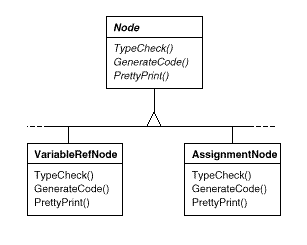
This diagram shows part of the Node class hierarchy. The problem here is that distributing all these operations across the various node classes leads to a system that's hard to understand, maintain, and change. It will be confusing to have type-checking code mixed with pretty-printing code or flow analysis code. Moreover, adding a new operation usually requires recompiling all of these classes. It would be better if each new operation could be added separately, and the node classes were independent of the operations that apply to them.
We can have both by packaging related operations from each class in a separate object, called a visitor, and passing it to elements of the abstract syntax tree as it's traversed. When an element "accepts" the visitor, it sends a request to the visitor that encodes the element's class. It also includes the element as an argument. The visitor will then execute the operation for that element—the operation that used to be in the class of the element.
For example, a compiler that didn't use visitors might type-check a procedure by calling the TypeCheck operation on its abstract syntax tree. Each of the nodes would implement TypeCheck by calling TypeCheck on its components (see the preceding class diagram). If the compiler type-checked a procedure using visitors, then it would create a TypeCheckingVisitor object and call the Accept operation on the abstract syntax tree with that object as an argument. Each of the nodes would implement Accept by calling back on the visitor: an assignment node calls VisitAssignment operation on the visitor, while a variable reference calls VisitVariableReference. What used to be the TypeCheck operation in class AssignmentNode is now the VisitAssignment operation on TypeCheckingVisitor.
To make visitors work for more than just type-checking, we need an abstract parent class NodeVisitor for all visitors of an abstract syntax tree. NodeVisitor must declare an operation for each node class. An application that needs to compute program metrics will define new subclasses of NodeVisitor and will no longer need to add application-specific code to the node classes. The Visitor pattern encapsulates the operations for each compilation phase in a Visitor associated with that phase.
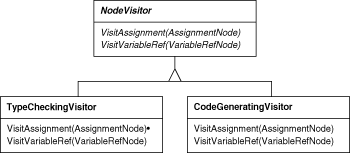
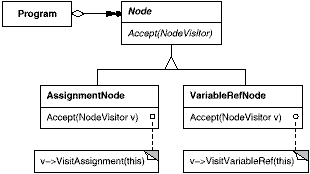
With the Visitor pattern, you define two class hierarchies: one for the elements being operated on (the Node hierarchy) and one for the visitors that define operations on the elements (the NodeVisitor hierarchy). You create a new operation by adding a new subclass to the visitor class hierarchy. As long as the grammar that the compiler accepts doesn't change (that is, we don't have to add new Node subclasses), we can add new functionality simply by defining new NodeVisitor subclasses.
 Applicability
ApplicabilityUse the Visitor pattern when
 Structure
Structure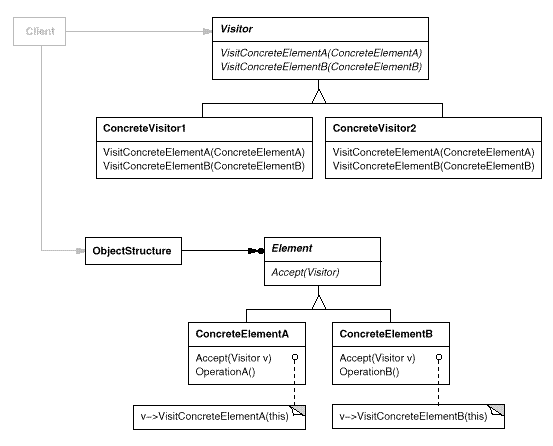
 Participants
Participants Collaborations
CollaborationsThe following interaction diagram illustrates the collaborations between an object structure, a visitor, and two elements:
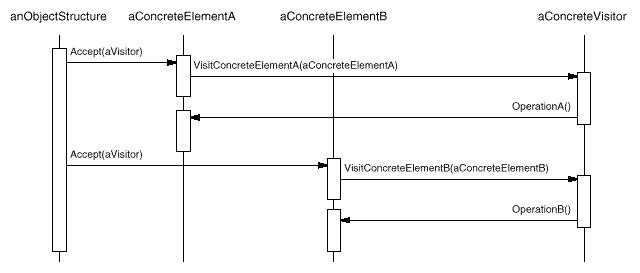
 Consequences
ConsequencesSome of the benefits and liabilities of the Visitor pattern are as follows:
So the key consideration in applying the Visitor pattern is whether you are mostly likely to change the algorithm applied over an object structure or the classes of objects that make up the structure. The Visitor class hierarchy can be difficult to maintain when new ConcreteElement classes are added frequently. In such cases, it's probably easier just to define operations on the classes that make up the structure. If the Element class hierarchy is stable, but you are continually adding operations or changing algorithms, then the Visitor pattern will help you manage the changes.
Item:
template
class Iterator {
// ...
Item CurrentItem() const;
};
This implies that all elements the iterator can visit have a common parent
class Item.
Visitor does not have this restriction. It can visit objects that don't have a common parent class. You can add any type of object to a Visitor interface. For example, in
class Visitor {
public:
// ...
void VisitMyType(MyType*);
void VisitYourType(YourType*);
};
MyType and YourType do not have to be related through
inheritance at all.
 Implementation
ImplementationEach object structure will have an associated Visitor class. This abstract visitor class declares a VisitConcreteElement operation for each class of ConcreteElement defining the object structure. Each Visit operation on the Visitor declares its argument to be a particular ConcreteElement, allowing the Visitor to access the interface of the ConcreteElement directly. ConcreteVisitor classes override each Visit operation to implement visitor-specific behavior for the corresponding ConcreteElement class.
The Visitor class would be declared like this in C++:
class Visitor {
public:
virtual void VisitElementA(ElementA*);
virtual void VisitElementB(ElementB*);
// and so on for other concrete elements
protected:
Visitor();
};
Each class of ConcreteElement implements an Accept operation
that calls the matching Visit... operation on the visitor
for that ConcreteElement. Thus the operation that ends up getting
called depends on both the class of the element and the class of the
visitor.10
The concrete elements are declared as
class Element {
public:
virtual ~Element();
virtual void Accept(Visitor&) = 0;
protected:
Element();
};
class ElementA : public Element {
public:
ElementA();
virtual void Accept(Visitor& v) { v.VisitElementA(this); }
};
class ElementB : public Element {
public:
ElementB();
virtual void Accept(Visitor& v) { v.VisitElementB(this); }
};
A CompositeElement class might implement Accept
like this:
class CompositeElement : public Element {
public:
virtual void Accept(Visitor&);
private:
List* _children;
};
void CompositeElement::Accept (Visitor& v) {
ListIterator i(_children);
for (i.First(); !i.IsDone(); i.Next()) {
i.CurrentItem()->Accept(v);
}
v.VisitCompositeElement(this);
}
Here are two other implementation issues that arise when you apply the Visitor pattern:
In single-dispatch languages, two criteria determine which operation
will fulfill a request: the name of the request and the type of
receiver. For example, the operation that a GenerateCode request will
call depends on the type of node object you ask. In C++, calling
GenerateCode on an instance of VariableRefNode will
call VariableRefNode::GenerateCode (which generates code for a
variable reference). Calling GenerateCode on an
AssignmentNode will call
AssignmentNode::GenerateCode (which will generate code for an
assignment). The operation that gets executed depends both on the kind
of request and the type of the receiver.
"Double-dispatch" simply means the operation that gets executed
depends on the kind of request and the types of two receivers.
Accept is a double-dispatch operation. Its meaning depends
on two types: the Visitor's and the Element's. Double-dispatching
lets visitors request different operations on each class of
element.11
This is the key to the Visitor pattern: The operation that gets
executed depends on both the type of Visitor and the type of Element
it visits. Instead of binding operations statically into the Element
interface, you can consolidate the operations in a Visitor and use
Accept to do the binding at run-time. Extending the Element
interface amounts to defining one new Visitor subclass rather than many new
Element subclasses.
Often the object structure is responsible for iteration. A collection will simply iterate over its elements, calling the Accept operation on each. A composite will commonly traverse itself by having each Accept operation traverse the element's children and call Accept on each of them recursively.
Another solution is to use an iterator to visit the elements. In C++,
you could use either an internal or external iterator, depending on what
is available and what is most efficient. In Smalltalk, you usually use
an internal iterator using do: and a block. Since internal
iterators are implemented by the object structure, using an internal
iterator is a lot like making the object structure responsible for
iteration. The main difference is that an internal iterator will not
cause double-dispatching—it will call an operation on the visitor with an element as an argument as opposed to calling an
operation on the element with the visitor as an argument.
But it's easy to use the Visitor pattern with an internal iterator if
the operation on the visitor simply calls the operation on the element
without recursing.
You could even put the traversal algorithm in the visitor, although you'll end up duplicating the traversal code in each ConcreteVisitor for each aggregate ConcreteElement. The main reason to put the traversal strategy in the visitor is to implement a particularly complex traversal, one that depends on the results of the operations on the object structure. We'll give an example of such a case in the Sample Code.
 Sample Code
Sample CodeBecause visitors are usually associated with composites, we'll use the
Equipment classes defined in the Sample Code of
Composite (163) to illustrate the Visitor pattern. We
will use Visitor to define operations for computing the
inventory of materials and the total cost for a piece of equipment.
The Equipment classes are so simple that using Visitor
isn't really necessary, but they make it easy to see what's
involved in implementing the pattern.
Here again is the Equipment class from
Composite (163). We've augmented it with an
Accept operation to let it work with a visitor.
class Equipment {
public:
virtual ~Equipment();
const char* Name() { return _name; }
virtual Watt Power();
virtual Currency NetPrice();
virtual Currency DiscountPrice();
virtual void Accept(EquipmentVisitor&);
protected:
Equipment(const char*);
private:
const char* _name;
};
The Equipment operations return the attributes of a piece of
equipment, such as its power consumption and cost. Subclasses redefine
these operations appropriately for specific types of equipment (e.g.,
a chassis, drives, and planar boards).
The abstract class for all visitors of equipment has a virtual function for each subclass of equipment, as shown next. All of the virtual functions do nothing by default.
class EquipmentVisitor {
public:
virtual ~EquipmentVisitor();
virtual void VisitFloppyDisk(FloppyDisk*);
virtual void VisitCard(Card*);
virtual void VisitChassis(Chassis*);
virtual void VisitBus(Bus*);
// and so on for other concrete subclasses of Equipment
protected:
EquipmentVisitor();
};
Equipment subclasses define Accept in
basically the same way: It calls the
EquipmentVisitor operation that corresponds to the class
that received the Accept request, like this:
void FloppyDisk::Accept (EquipmentVisitor& visitor) {
visitor.VisitFloppyDisk(this);
}
Equipment that contains other equipment (in particular, subclasses of
CompositeEquipment in the Composite pattern) implements
Accept by iterating over its children and calling
Accept on each of them. Then it calls the
Visit operation as usual.
For example, Chassis::Accept could traverse
all the parts in the chassis as follows:
void Chassis::Accept (EquipmentVisitor& visitor) {
for (
ListIterator i(_parts);
!i.IsDone();
i.Next()
) {
i.CurrentItem()->Accept(visitor);
}
visitor.VisitChassis(this);
}
Subclasses of EquipmentVisitor define particular algorithms
over the equipment structure. The PricingVisitor computes the
cost of the equipment structure. It computes the net price of all simple
equipment (e.g., floppies) and the discount price of all composite
equipment (e.g., chassis and buses).
class PricingVisitor : public EquipmentVisitor {
public:
PricingVisitor();
Currency& GetTotalPrice();
virtual void VisitFloppyDisk(FloppyDisk*);
virtual void VisitCard(Card*);
virtual void VisitChassis(Chassis*);
virtual void VisitBus(Bus*);
// ...
private:
Currency _total;
};
void PricingVisitor::VisitFloppyDisk (FloppyDisk* e) {
_total += e->NetPrice();
}
void PricingVisitor::VisitChassis (Chassis* e) {
_total += e->DiscountPrice();
}
PricingVisitor will compute the total cost of all nodes in the
equipment structure. Note that PricingVisitor chooses the
appropriate pricing policy for a class of equipment by dispatching to
the corresponding member function. What's more, we can change the
pricing policy of an equipment structure just by changing the
PricingVisitor class.
We can define a visitor for computing inventory like this:
class InventoryVisitor : public EquipmentVisitor {
public:
InventoryVisitor();
Inventory& GetInventory();
virtual void VisitFloppyDisk(FloppyDisk*);
virtual void VisitCard(Card*);
virtual void VisitChassis(Chassis*);
virtual void VisitBus(Bus*);
// ...
private:
Inventory _inventory;
};
The InventoryVisitor accumulates the totals for each type of
equipment in the object structure. InventoryVisitor uses an
Inventory class that defines an interface for adding equipment
(which we won't bother defining here).
void InventoryVisitor::VisitFloppyDisk (FloppyDisk* e) {
_inventory.Accumulate(e);
}
void InventoryVisitor::VisitChassis (Chassis* e) {
_inventory.Accumulate(e);
}
Here's how we can use an InventoryVisitor on an
equipment structure:
Equipment* component;
InventoryVisitor visitor;
component->Accept(visitor);
cout << "Inventory "
<< component->Name()
<< visitor.GetInventory();
Now we'll show how to implement the Smalltalk example from the Interpreter pattern (see page 248) with the Visitor pattern. Like the previous example, this one is so small that Visitor probably won't buy us much, but it provides a good illustration of how to use the pattern. Further, it illustrates a situation in which iteration is the visitor's responsibility.
The object structure (regular expressions) is made of four classes,
and all of them have an accept: method that takes the
visitor as an argument. In class SequenceExpression, the
accept: method is
accept: aVisitor
^ aVisitor visitSequence: self
In class RepeatExpression, the accept: method
sends the visitRepeat: message.
In class AlternationExpression, it sends the
visitAlternation: message.
In class LiteralExpression, it sends the
visitLiteral: message.
The four classes also must have accessing functions that the visitor
can use. For SequenceExpression these are
expression1 and expression2; for
AlternationExpression these are alternative1
and alternative2; for
RepeatExpression it is repetition; and for
LiteralExpression these are components.
The ConcreteVisitor class is REMatchingVisitor. It
is responsible for the traversal because its traversal algorithm
is irregular. The biggest irregularity is that a
RepeatExpression will repeatedly traverse its component.
The class REMatchingVisitor has an instance variable
inputState. Its methods are essentially the same as
the match: methods of the expression classes in the
Interpreter pattern except they
replace the argument named inputState with the
expression node being matched. However, they
still return the set of streams that the expression would match
to identify the current state.
visitSequence: sequenceExp
inputState := sequenceExp expression1 accept: self.
^ sequenceExp expression2 accept: self.
visitRepeat: repeatExp
| finalState |
finalState := inputState copy.
[inputState isEmpty]
whileFalse:
[inputState := repeatExp repetition accept: self.
finalState addAll: inputState].
^ finalState
visitAlternation: alternateExp
| finalState originalState |
originalState := inputState.
finalState := alternateExp alternative1 accept: self.
inputState := originalState.
finalState addAll: (alternateExp alternative2 accept: self).
^ finalState
visitLiteral: literalExp
| finalState tStream |
finalState := Set new.
inputState
do:
[:stream | tStream := stream copy.
(tStream nextAvailable:
literalExp components size
) = literalExp components
ifTrue: [finalState add: tStream]
].
^ finalState
 Known Uses
Known UsesThe Smalltalk-80 compiler has a Visitor class called ProgramNodeEnumerator. It's used primarily for algorithms that analyze source code. It isn't used for code generation or pretty-printing, although it could be.
IRIS Inventor [Str93] is a toolkit for developing 3-D graphics applications. Inventor represents a three-dimensional scene as a hierarchy of nodes, each representing either a geometric object or an attribute of one. Operations like rendering a scene or mapping an input event require traversing this hierarchy in different ways. Inventor does this using visitors called "actions." There are different visitors for rendering, event handling, searching, filing, and determining bounding boxes.
To make adding new nodes easier, Inventor implements a double-dispatch scheme for C++. The scheme relies on run-time type information and a two-dimensional table in which rows represent visitors and columns represent node classes. The cells store a pointer to the function bound to the visitor and node class.
Mark Linton coined the term "Visitor" in the X Consortium's Fresco Application Toolkit specification [LP93].
 Related Patterns
Related PatternsComposite (163): Visitors can be used to apply an operation over an object structure defined by the Composite pattern.
Interpreter (243): Visitor may be applied to do the interpretation.

 Discussion of Behavioral Patterns
Discussion of Behavioral Patterns
 Template Method
Template Method
10We could use function overloading to give these operations
the same simple name, like Visit, since the operations are
already differentiated by the parameter they're passed. There are
pros and cons to such overloading. On the one hand, it reinforces the
fact that each operation involves the same analysis, albeit on a
different argument. On the other hand, that might make what's going
on at the call site less obvious to someone reading the code. It
really boils down to whether you believe function overloading is good
or not.

If we can have double-dispatch, then why not
triple or quadruple, or any other number? Actually,
double-dispatch is just a special case of multiple
dispatch, in which the operation is chosen based on any number of
types. (CLOS actually supports multiple dispatch.) Languages that
support double- or multiple dispatch lessen the need for the
Visitor pattern.
